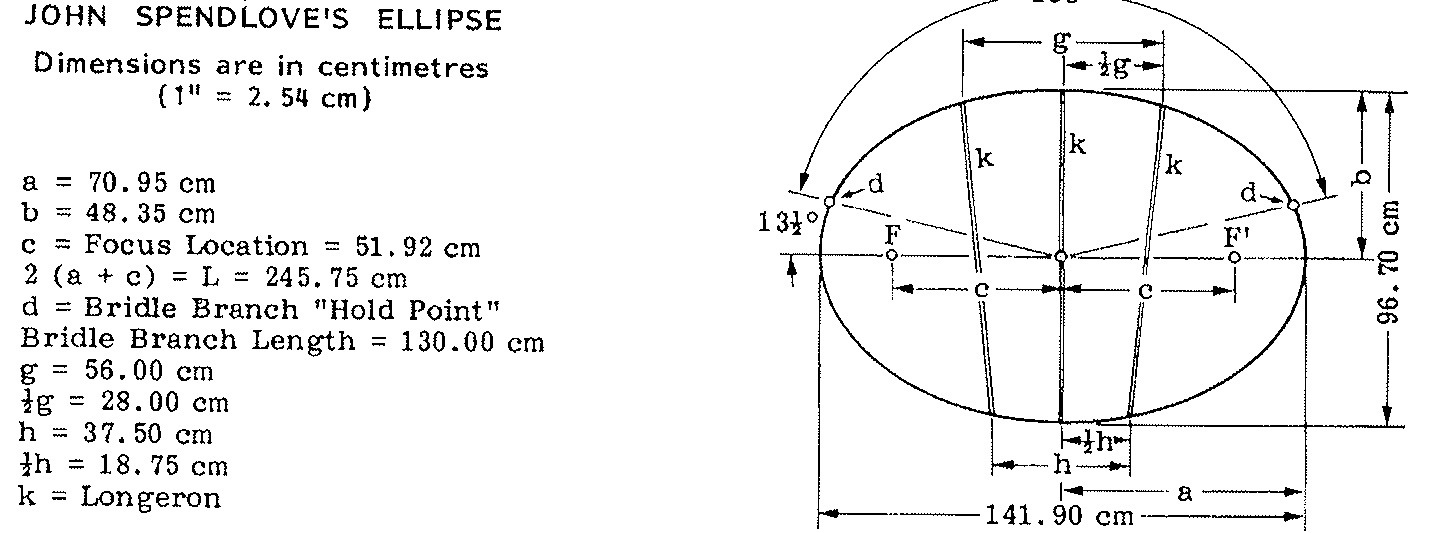Copyright © 1981 by Guy D. Aydlett
THREE ALLlFLEX KlTES FROM THREE FAMOUS KlTEFLlERS
Spendlove, Greger, Ond Weathers
JO HN SPENDLO VE , International Secretary for Englnnd’s Northern K ite Group , derived his euipt not flyer from “FLUTE 163,” n f1exiT›1e Site de aigne d by HELEN BUSHELL , of Australia (see “Bushell, ” page 6) . John used strnws—long soda strnw s?—and tiasue paper to create a 6 4- gramme Site (inclu ding bridle and swivel) with an area of I . 078 m 2 . John’s kite will give you a cnance to exercise the etlip se layout technique a sketched on page 2, and a good chance to run off some practical met creation . Just buy a metre rule anci have at it . Decimal measurement s are eosy to use ; pleasant to uee in cafeulationa.
MARGARET GREGER’S and WARREN O. “STORMY ” WEAT HERS ‘ flexible kites, dimensioned b elow , are self-kites— essentially stiekle ss. 5t apled or taped pleat s provicte the functione of Ion gerons . Margaret sent her sampIe from R iehlan d , Washington ; S tormy’s come from I\4 ilwauRie , Ore gon . Both kites fly well in gentle to moderate winds ; both are easy to make :

OLLA PODRIDA
WAYNE BAT TELLE , this anniversary iesue fs deCtic ated to you , our first subscribes . From New York , on the 6th of August , Wayne sent this: “…Your witty end in- formative DA T A -k E T T in in a joy—count on
me as a permanent subscribes.” lB I u s he s!
HELEN BUSHELL , An stralin’s famous Kite Lady , wrote to PMAF in August and mentioned that she has found on interesting “hold-point” constunt for flexible Sites of the Allison kind (Aiiinexe s) . She wrote: “A few years ago , 1 worked on circular sleFte …they … gave me some easy mathematics and the curious constant that was published in two issue s of the European Kitefyer emerged.
“You might not have seen these, so here is the gist of it: In a circular sled with paralell Iongerons , the most comfortable place for the hold points is … almost 154° from the measured centre of the kite , no matter whether the longerons are close together or far apartbut they must be para11e1 .
“Taking it further , I used wider than circular and taller than circular [ellipticolI sleds anfi found the 154° hold point to suit those , too ….
“achieved it ithe anseer) empirically by holding a made-up circular sled by the sides ct (and close to the halfway mark and fanning it to and fro . ”
Helen’e armstrong wind-Iunnel gave her “hold ,” or b ridle , points that looke ñ like this

AUTOROY ATION— self-excite it rotation —is a phenomenon that makes it possible for
.rotor Sites to rotate and fly with only the wind os an energy source . In t he Hornbearn Rotor 661 Kite Plan •e zie s (D A T A -fzET T E RS 9, 10 , a 11) , brief mention was made re- gar ding flat-plate rotor kites i but no dis- cussioiof the sub ject we s included to ease the intellect ual pains of the curious .
Here is a follow- up that shoulit satisfy all but the most egg-heade d aeronautical re- searchers: Honnt your library and look for “Mechanical Vib rations” by J. P . Den Har- tog ( MeG raw – Hill , 2nd ed . , 1940) . Poges 34 7- 53 are devoted to tempting fnre such os: Lnncheste r’s Aeriel Tourbitlon, llft rind drug n s function s of angle s of ct tack for symmetrical cross— sections , K ârmfin vor-tices in o wake , and the “B ullrroare Effect”
LINE-W 1NDERS (r eels, skeiners, or other s) nre perh aps the len st satisfactory portion of o kiteflier’s equipment. Most fliers es- pouse some form in preference to others i but neorly everyone agrees thnt the w inder state-of-art lugs far behind development s of the other t wo major components—lines and Sites, themselves . Piney Mountain’s fliers prefer the frame -w in ber ( sometimes misn8med “bobbin ” ) , a simple recton gulor structure equipped with sturdy hen dgrip s nt alternate corners . be promise to draft a plan for a good one early in 1982. (If you jump the gun and make one before the plon is published , be sure to make it much sturdier than most that are available in the marketplace . The true tensions in consec- utive loops acc yW u late, often crush weakly fab riveted winders .
SUPPORT LOW-VELOCITY FLIGHT RESEARCH: Subscribe to the Monthly DATA-LETTER
By First Class Mail in the U.S.A. : $7.50 per year, or 75′ per copy
Send check or money order (no cash) to
Guy D. Aydlett Box 7304
Charlottesville, VA 22906


